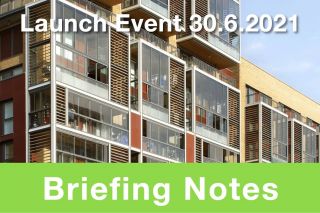
www.buildingsandcities.org/insights/news/inequalities-indoor-air-pollution.html
Systemic inequalities in indoor air pollution exposure

Exposure to air pollution is one of the greatest health risks in many countries, for example causing an estimated 28,000 - 36,000 premature deaths a year in the UK. Low-income households are exposed to higher levels of outdoor and indoor air pollution. What leads to these indoor exposure inequalities and what can be done to reduce them?
New peer
reviewed research by Ferguson et al. in "Systemic inequalities in indoor air pollution exposure in London, UK" collects
evidence from various models, datasets, and previously published studies to
show why low-income households may be exposed to higher levels of indoor air
pollution in London. It then links these factors together to demonstrate how
these exposure disparities are in part due to housing and environmental factors
that are outside of the control of the occupants themselves, and are therefore an
area of systemic inequality.
Most studies that examine inequalities in air pollution exposure rely on outdoor air pollution concentrations, and in many UK cities, evidence shows that outdoor air pollution is highest in more deprived neighbourhoods. However, in the UK as with other developed countries, people spend around 80-90% of their time indoors, meaning indoor air pollution is likely to be more important when looking at overall exposure. Emerging evidence suggests that low-income populations in developed countries also experience higher concentrations of air pollution in the indoor environment (Ferguson et al. 2021). To understand why low-income households may be exposed to higher levels of indoor air pollution - and more at-risk from this exposure - the authors collected evidence from various models, datasets and previously published studies using London as a case study. Factors which influence exposure are related to the surrounding environment, housing quality, and occupant behaviours.
Levels of outdoor air pollution can be impacted by the number of local sources, such as road transport, and pollution can enter into houses through cracks, vents, opened windows or ventilation systems. This paper supports previous research by showing how low-income households tend to live in areas with higher levels of outdoor air pollution, as well as providing new evidence of how low-income neighbourhoods tend to be closer to busy roads. The paper shows that, whilst low-income housing is on average more airtight than the rest of the building stock, indoor concentrations of air pollution from outdoor sources are still higher in low-income households due to higher outdoor levels.
Another important factor is housing quality. While the greater airtightness seen in low-income housing can help reduce the amount of outdoor air pollution that reaches the indoor environment, it can also limit the ability to remove pollution from indoor sources, for example air pollution generated by activities such as cooking or smoking. This means it is particularly important to have additional ventilation options, such as extract fans, but evidence indicates that low-income households are much more likely to have broken extract fans. In addition, such individuals are more likely to live in dwellings with shared walls and floors, increasing the chances of pollution entering from neighbouring dwellings, and are more likely to live in smaller dwellings that can accumulate air pollution from indoor sources faster.
A third important factor is the behaviour of occupants. Evidence collected in this paper shows how low-income households are more likely to smoke indoors, tend to spend more time cooking, and may be less likely to open windows to ventilate due to security concerns. Dwellings are more likely to be overcrowded, with more people creating pollution indoors. And, low-income individuals are also more likely to spend time at home, increasing the relative importance of indoor air pollution for such groups.
Finally, low-income populations have higher underlying rates of disease than the rest of the population, which may act to make them more susceptible to negative health effects due to these exposures. Acting together as a system, these factors can increase indoor air pollution concentrations and the amount of time spent exposed to them, for a sub-group of the population already vulnerable to poor health outcomes. Exposure to indoor air pollution is therefore considered an area of systemic inequality. The negative consequences may reinforce themselves - for example, as exposure to air pollution makes an individual sicker, they may need to spend longer at home, further increasing the role of indoor air pollution on health. And, many of these factors, such as the surrounding environment, neighbours, and housing quality are outside of the control of a population sub-group that largely rents their homes from landlords or housing providers, and do not have the financial resources to move elsewhere or political power to demand change.
Therefore, any measures to address indoor air pollution inequalities need to address these systemic issues if they hope to succeed. Rather than focusing on behaviours and health outcomes, policies that improve low-income housing and the surrounding environment are going to be critical to address health inequalities from air pollution in the future.
Reference
Ferguson, L., Taylor, J., Zhou, K., Shrubsole, C., Symonds, P., Davies, M., Dimitroulopoulou, S. (2021). Systemic inequalities in indoor air pollution exposure in London, UK. Buildings and Cities, 2(1), 411-434. https://doi.org/10.5334/bc.100
Funding
The research was funded by the Engineering and Physical Sciences Research Council (UK) Centre for Doctoral Training in Energy Demand and the Public Health England PhD Studentship Fund. Additional support is from the Wellcome Trust for the 'Complex Urban Systems for Sustainability and Health' (CUSSH) project.
Latest Peer-Reviewed Journal Content
A living lab approach to co-designing climate adaptation strategies
M K Barati & S Bankaru-Swamy
Mediation roles and ecologies within resilience-focused urban living labs
N Antaki, D Petrescu, M Schalk, E Brandao, D Calciu & V Marin
Negotiating expertise in Nepal’s post-earthquake disaster reconstruction
K Rankin, M Suji, B Pandey, J Baniya, D V Hirslund, B Limbu, N Rawal & S Shneiderman
Designing for pro-environmental behaviour change: the aspiration–reality gap
J Simpson & J Uttley
Lifetimes of demolished buildings in US and European cities
J Berglund-Brown, I Dobie, J Hewitt, C De Wolf & J Ochsendorf
Expanding the framework of urban living labs using grassroots methods
T Ahmed, I Delsante & L Migliavacca
Youth engagement in urban living labs: tools, methods and pedagogies
N Charalambous, C Panayi, C Mady, T Augustinčić & D Berc
Co-creating urban transformation: a stakeholder analysis for Germany’s heat transition
P Heger, C Bieber, M Hendawy & A Shooshtari
Placemaking living lab: creating resilient social and spatial infrastructures
M Dodd, N Madabhushi & R Lees
Church pipe organs: historical tuning records as indoor environmental evidence
B Bingley, A Knight & Y Xing
A framework for 1.5°C-aligned GHG budgets in architecture
G Betti, I Spaar, D Bachmann, A Jerosch-Herold, E Kühner, R Yang, K Avhad & S Sinning
Net zero retrofit of the building stock [editorial]
D Godoy-Shimizu & P Steadman
Co-learning in living labs: nurturing civic agency and resilience
A Belfield
The importance of multi-roles and code-switching in living labs
H Noller & A Tarik
Researchers’ shifting roles in living labs for knowledge co-production
C-C Dobre & G Faldi
Increasing civic resilience in urban living labs: city authorities’ roles
E Alatalo, M Laine & M Kyrönviita
Co-curation as civic practice in community engagement
Z Li, M Sunikka-Blank, R Purohit & F Samuel
Preserving buildings: emission reductions from circular economy strategies in Austria
N Alaux, V Kulmer, J Vogel & A Passer
Urban living labs: relationality between institutions and local circularity
P Palo, M Adelfio, J Lundin & E Brandão
Living labs: epistemic modelling, temporariness and land value
J Clossick, T Khonsari & U Steven
Co-creating interventions to prevent mosquito-borne disease transmission in hospitals
O Sloan Wood, E Lupenza, D M Agnello, J B Knudsen, M Msellem, K L Schiøler & F Saleh
Circularity at the neighbourhood scale: co-creative living lab lessons
J Honsa, A Versele, T Van de Kerckhove & C Piccardo
Positive energy districts and energy communities: how living labs create value
E Malakhatka, O Shafqat, A Sandoff & L Thuvander
Built environment governance and professionalism: the end of laissez-faire (again)
S Foxell
Co-creating justice in housing energy transitions through energy living labs
D Ricci, C Leiwakabessy, S van Wieringen, P de Koning & T Konstantinou
HVAC characterisation of existing Canadian buildings for decarbonisation retrofit identification
J Adebisi & J J McArthur
Simulation and the building performance gap [editorial]
M Donn
Developing criteria for effective building-sector commitments in nationally determined contributions
P Graham, K McFarlane & M Taheri
Join Our Community

The most important part of any journal is our people – readers, authors, reviewers, editorial board members and editors. You are cordially invited to join our community by joining our mailing list. We send out occasional emails about the journal – calls for papers, special issues, events and more.
We will not share your email with third parties. Read more



Latest Commentaries
COP30 Report
Matti Kuittinen (Aalto University) reflects on his experience of attending the 2025 UN Conference of the Parties in Belém, Brazil. The roadmaps and commitments failed to deliver the objectives of the 2025 Paris Agreement. However, 2 countries - Japan and Senegal - announced they are creating roadmaps to decarbonise their buildings. An international group of government ministers put housing on the agenda - specifying the need for reduced carbon and energy use along with affordability, quality and climate resilience.
Building-Related Research: New Context, New Challenges
Raymond J. Cole (University of British Columbia) reflects on the key challenges raised in the 34 commissioned essays for Buildings & Cities 5th anniversary. Not only are key research issues identified, but the consequences of changing contexts for conducting research and tailoring its influence on society are highlighted as key areas of action.